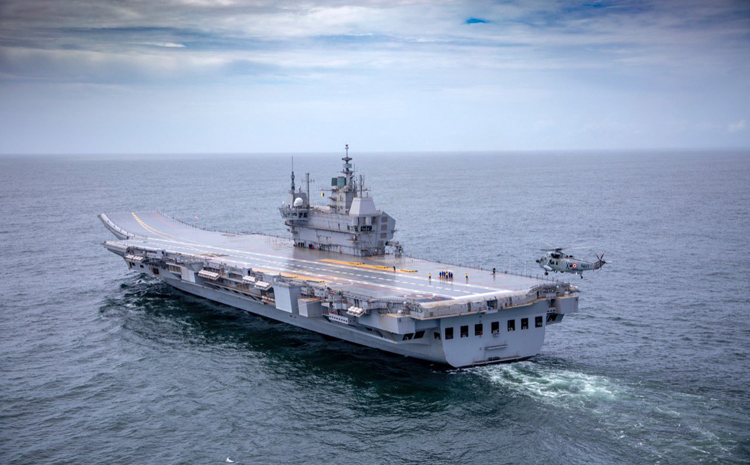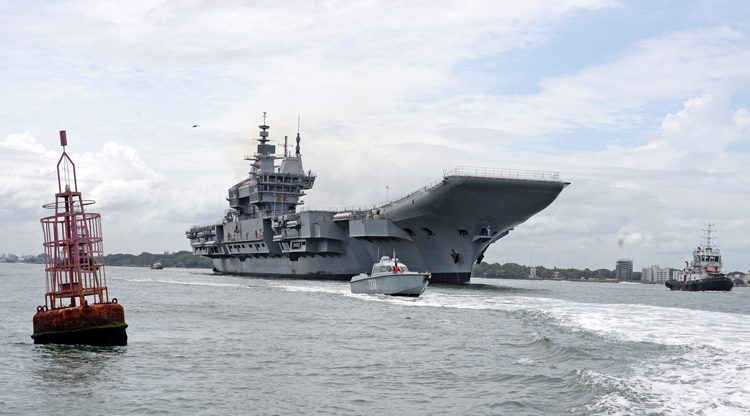INDIAN ARMED FORCES CHIEFS ON OUR RELENTLESS AND FOCUSED PUBLISHING EFFORTS

The insightful articles, inspiring narrations and analytical perspectives presented by the Editorial Team, establish an alluring connect with the reader. My compliments and best wishes to SP Guide Publications.

"Over the past 60 years, the growth of SP Guide Publications has mirrored the rising stature of Indian Navy. Its well-researched and informative magazines on Defence and Aerospace sector have served to shape an educated opinion of our military personnel, policy makers and the public alike. I wish SP's Publication team continued success, fair winds and following seas in all future endeavour!"

Since, its inception in 1964, SP Guide Publications has consistently demonstrated commitment to high-quality journalism in the aerospace and defence sectors, earning a well-deserved reputation as Asia's largest media house in this domain. I wish SP Guide Publications continued success in its pursuit of excellence.
- Operation Sindoor: Resolute yet Restrained
- India’s Operation Sindoor Sends a Clear Message to Terror and the World – ‘ZERO TOLERANCE’
- Japan and India set forth a defence cooperation consultancy framework, talks on tank and jet engines
- Terrorist Attack in Pahalgam in Kashmir: Unfolding a long surgical war against PAK
- Lt General Pratik Sharma takes over Command of Indian Army's Northern Command
Vikrant's Light Signaling System
Indian Navy personnel have been trained by Aerosvet's engineers in installation of light signaling system on INS Vikrant
 |
The Author is Former Director General of Information Systems and A Special Forces Veteran, Indian Army |

India’s indigenous aircraft carrier INS ‘Vikrant’, also known as IAC, setting out for sea trial on August 4, 2021, has been covered in these columns earlier. The construction of IAC, which is 262 metres long, 62 metres wide and having a height of 59 metres, began at the Cochin Shipyard Limited (CSL) in 2009. Around 550 Indian firms including about 100 MSMEs with the CSL provided various services in the construction of the IAC.
The 40,000 tonnes warship which will host MiG-29K fighter jets, Kamov-31 helicopters and MH-60R multirole helicopters, has over 2,300 compartments, designed for a crew of around 1,700 personnel including specialised cabins to accommodate women officers. The IAC, built at a cost of around 23,000 crore, has been described by the Navy as "historic" as it propelled India into a select group of countries having capabilities to build state-of-the-art aircraft carriers.
The IAC has propelled India into a select group of countries having capabilities to build state-of-the-art aircraft carriers
On August 14, the Southern Naval Command (SNC) invited media persons onboard INS Vikrant at Kochi, which had completed its sea trials on August 8. The aim was to offer them sneak peek into the engineering marvel of the aircraft carrier. Vice Admiral A.K. Chawla, Flag Officer Commanding-in-Chief of SNC told media persons that Vikrant’s five-day sea trial was a "glowing testimonial" to the country's vision of an Atmanirbhar Bharat. He added, "It demonstrates the Indian Navy's capability to design and oversee the construction of the most complex of warships, as also the capability of our ship-builders and industries to successfully execute such a large and complex ship-building project."
Commander Sreejith, a senior electrical overseer officer, told media that "the power used in the ship can light up half of the Kochi city" albeit the exact power generated in the ship cannot be disclosed being classified information. He, however added, "All the major electrical industries including BHEL have contributed to the construction of this ship. We have used approximately 2,600 km-long cable in this." The power generated in the ship is used for electrical systems including the radar system, communications, navigation, propulsion power generation, steering, air conditioning, food storage, safety related systems, medical systems among others.

Interestingly, work was completed on the installation of lighting systems on INS Vikrant in the first half of August 2021 by the Russian company Aerosvet. Work on the installation of lighting systems had begun in the spring of 2021 but unfortunately installation of Aerosvet products was suspended for almost a month due to the spread of COVID-19 that occurred at the crucial time of installation.
For five months, Russian specialists trained Indian engineers in the installation of devices, monitored the process, checked the quality of the installation, and eliminated shortcomings. Engineers of Aerosvet installed the Saturn combat system on board the aircraft carrier Vikrant; the system provides for take-off and landing of aircraft, as well as deck illumination for mooring, refueling and ammunition, etc. Both types of lighting equipment were developed by the Russia’s Aerosvet. INS Vikrant is equipped with lighting systems from the lower deck to its superstructure.
Aerosvet's cooperation with the Indian Navy is not limited to the launch of the aircraft carrier Vikrant. They are servicing the Indian aircraft-carrier Vikramaditya, as well as the Shore-Based Test Facility on the island of Goa
Aerosvet's cooperation with the Indian Navy is not limited to the launch of the aircraft carrier Vikrant. The Russian manufacturer is servicing the Indian aircraft-carrier Vikramaditya (formerly the Admiral Gorshkov cruiser), as well as the Shore-Based Test Facility on the island of Goa. Here, representatives of the Russian company undertake checks on a regular basis, if necessary replace previously installed equipment, and give recommendations for future improvements and modifications. In addition, Aerosvet's management aims to certify the company's products in accordance with the standards of the International Civil Aviation Organization (ICAO) through further cooperation.
INS Vikrant is likely to be handed over to the Indian Navy around the spring of 2022. The intervening period will witness multiple training and testing stages for the crew who would serve on the aircraft carrier, which would include: Mooring Trials - during which the ship is at the berth. This stage includes measurements, instrumental testing, touching flights and the like; Running Trials – undertaken at sea to test successful mutual interaction among each complex installed on the aircraft carrier, and; State Tests – to include landing of helicopters and aircraft on the deck in varying degrees of visibility; by night, in twilight, in foggy conditions etc.
This will help our engineers install similar systems on their own when we build our next indigenous aircraft carriers
Though INS Vikrant is hailed as the first indigenous aircraft carrier India has produced, actually only about 76 percent is indigenous.It is good that our naval personnel have been trained by Aerosvet's engineers in installation of light signaling system on INS Vikrant. This will help our engineers install similar systems on their own when we build our next indigenous aircraft carriers. However, the fact that we did not develop an indigenous light signaling system indicates that we have a long way to go.





